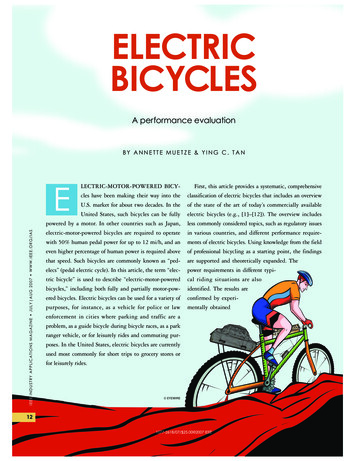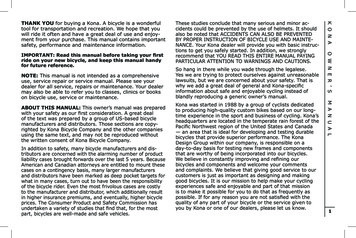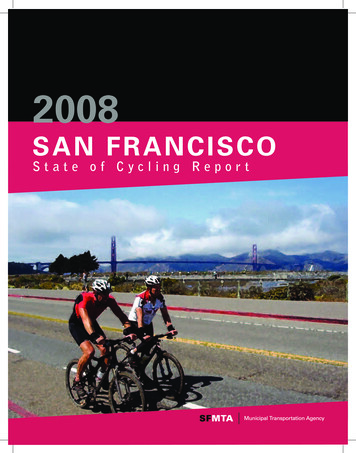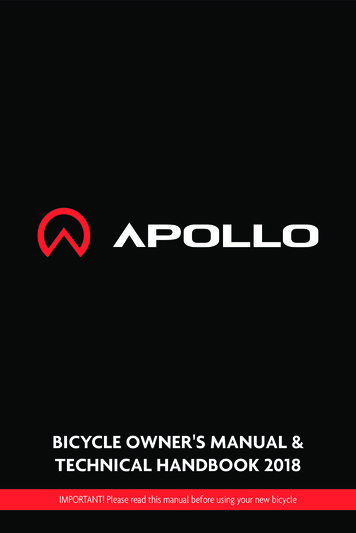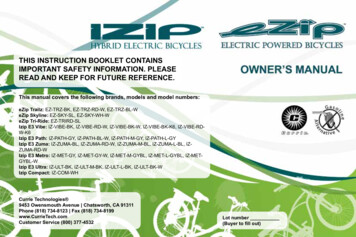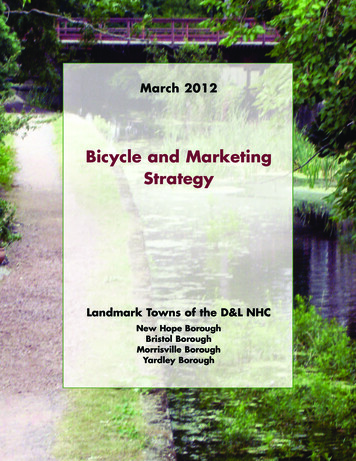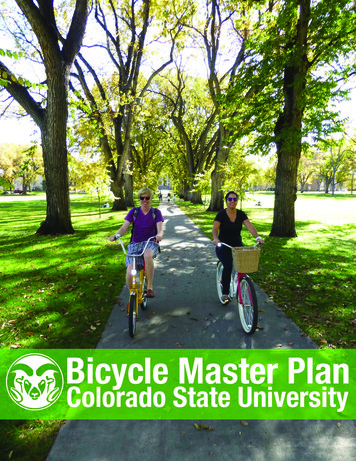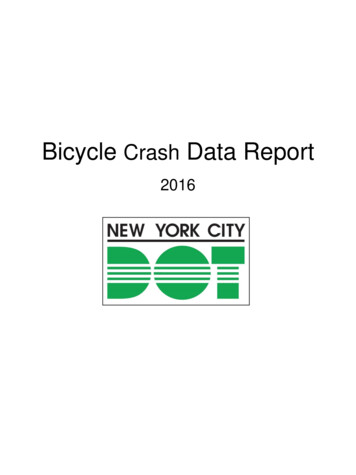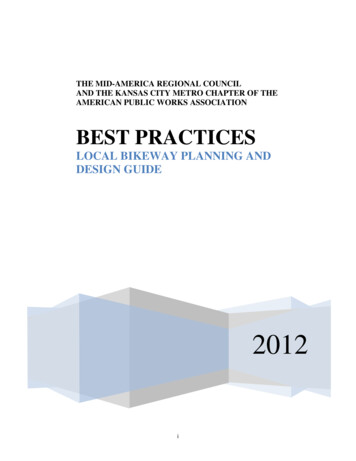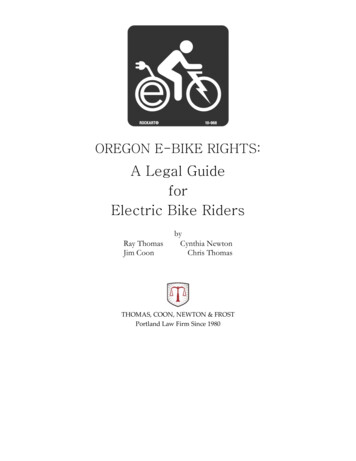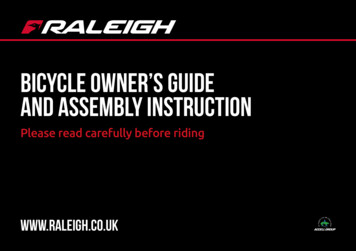
Transcription
BICYCLE OWNER’S GUIDEand ASSEMBLY INSTRUCTIONPlease read carefully before ridingwww.raleigh.co.ukfor further information consult our website www.raleigh.co.uk
CONTENTS21 POINT PRE-DELIVERY INSPECTION4. KNOW YOUR BIKEEach item should be ticked by the mechanic undertaking the Pre-Delivery Inspection (PDI) and signed at the end tocertify that the cycle is being handed over in first class condition. All riders, including Mail Order customers, are urgedto make similar periodic safety checks for themselves, or have them done by a retailer, using this list as a guide.5.QUICK ASSEMBLY GUIDE10. PERSONAL SAFETY13. RIDING WITH JUNIORS14. STEERING, HEADSETSAND HANDLEBARS16. PEDALS17. QUICK RELEASE WHEELS18. SADDLE ADJUSTMENT20. BRAKES1Fit all of the loose equipment supplied with the bike andtighten pedals, toe clips and straps 12 to customer, depending on likely use.2Adjust wheel quick releases and position levers correctly.Tighten wheel nuts, where fitted, and explain theimportance of correct chain tension where necessary 13 demonstrate how to adjust the springs where applicable.3Spin wheels to check trueness, then test tyre pressures. 27. CRANKS28. GEARSLubricate chain and suggest appropriate lubricant Suspension bikes – forks only: sit customer on saddle and Full suspension bikes: sit customer on saddle anddemonstrate how to adjust the rear suspension, and14 then the front. Check that the bike is level when the whole weight of the customer is placed on the saddle.4Check that the saddle height and fore and aft adjustmentare correctly matched to the customer. 5Check handlebar height and handlebar angle are correctlymatched to the customer. 15 mounted on the bike before purchase are correctly fitted6Make sure that the seat post and handlebar stem arenot extended further than the safety limit line. 16 gear cable and remove back wheel.7Tighten saddle clip, saddle adjustment bolt, handlebarstem fixing, handlebar clamp bolt and bar ends. 17 360 without getting the brake cables caught up8Test brakes and check pad position, adjusting as required.Check front brake is connected to right hand lever. Checkthat customer can reach the brake lever comfortably. 18 reach to suit individual customer. Explain to parents and Demonstrate effectiveness of braking system to customerand explain the danger of pitch-over, especially if thebrakes are allowed to lock. 19 See page 6 for location.Frame Numbers (To be recorded by PDI mechanic). 20 the customer and ensure that he or she is happy with 21 Check chainwheel and crank bolt torque is 42-45Nm. 34. SPECIALIST BIKES36. BMX38. R ACE/TOURING/CARBONFRAMES & FORKS40. MAINTENANCE46. CLOTHING &ACCESSORIESMechanic’s signature:.9Customer’s signature:.Check that the gears change cleanly and adjust10 as necessary.Show customer how to change gear and explain that lowDate:.211 gears should be used for climbing hills, middle gears forthe flat and high gears for downhill.Check that any extra-cost equipment or any accessoriesand safe. Explain how to use them to the customer.Hub gear bikes: explain to customer how to disconnectBMX bikes: test that steering can be rotated through(gyro models only).Kid’s bikes: Sit rider on bike and check that the rider canplace both feet flat on the ground. Adjust brake leverchildren that the use of garage air lines is dangerous.Explain the guarantee and servicing arrangements toeverything before signing off below.for further information consult our website www.raleigh.co.uk
WELCOME TO THE FAMILYWhen Sir Frank W. Bowden started Raleigh Bicycles in Nottingham UK, in 1887we are certain that he would have pictured you stood here today with your newbicycle, which comes steeped with the innovation and expertise that you get fromdesigning bikes for over 125 years.You see, Sir Frank was a visionary who took a small bicycle company from RaleighStreet, Nottingham, into every corner of the globe. It was Sir Frank’s ability to picturethe impossible that drove us to create the world’s most recognisable bike brand.Without his inspirational foresight and huge leaps of imagination we wouldn’t havehad classic Raleighs like the All Steel Roadster, the Superbe and Clubman. Nor forthat matter would we have had iconic bikes like the Chopper, Burner and Grifter.And certainly wouldn’t have inspired the careers of professional cyclists like A.A.Zimmerman, Tommy Godwin, Reg Harris, Joop Zoetemelk, Sir Chris Hoy and ‘today’sTeam Raleigh superstars’.Sir Frank’s vision has been evident in Raleigh for over 125 years, helping us driveRaleigh forward to create today’s cutting edge race-winning performance bikes, aswell as our beautiful classic bikes, around-town everyday bikes and beginner bikesfor tomorrow’s riders. From your first bike to your fastest, Raleigh has been thereevery step of the way for generations and generations.Raleigh Bikesfor further information consult our website www.raleigh.co.uk3
IMPORTANT - KNOW YOUR BIKECheck that you use your bike correctly.Type of use for whichbike is designedPermissible total weightof rider luggageTrekking &City BikesRiding on roads andtracks. Not for off roador rough terrain120 Kg (19 stone)Mountain &Cyclocross BikesOff road, rough terrain, cycletracks or road120 Kg (19 stone)Racing BikesHigh Speed amateur use onpublic roads Not for off roador rough terrain.120 Kg (19 stone)BMX BikesOn road, cycletracks,and/or ramps. Not foruse in sanctioned competitionevents120 Kg (19 stone)IMPORTANT: FAILURE TO USE YOUR BIKE IN ACCORDANCE WITH THE ABOVE RECOMMENDATIONS COULD RESULT IN SERIOUS INJURY4for further information consult our website www.raleigh.co.uk
QUICK ASSEMBLY GUIDEIMPORTANTPlease read these instructions carefully.For more detailed information and tips, includinga comprehensive guide to care and maintenance werecommend you read the owners guide in detail.This bike is fully adjusted and checked over at the factory. The handlebars maybe removed or assembled in the bike and turned through 90 degrees. Thepedals removed and in some cases the front wheel will have been removedtoo. It is a relatively simple operation to re-assemble these parts, however ifyou do not feel competent to do this you should ask someone who is, as it isimportant that these simple tasks are done correctly for the integral safety ofthe bike. If in doubt consult a qualified mechanic or cycle dealer.UNPACKINGPlease remove all packaging very carefully, especially if using a knife or sharpblade. Take care not to scratch any of the parts of the bike or slash the tyres.We suggest that you keep hold of the carton in case you need to return the bike.SUPPLIED WITH YOUR BIKE (WHERE APPLICABLE) Allen key (s) Multi-spanner Pedals ReflectorsFOR DETAILED ADJUSTMENT AND OTHER INFORMATIONPLEASE REFER TO THE SPECIFIC SECTIONS IN THIS GUIDEScan these QRcodes to view ourassembly videos for further information consult our website www.raleigh.co.ukBMX assemblyBike assembly5
PREPARING YOUR BIKE FOR ASSEMBLY445108123112146FRAME NO.8.Seat tube2. Front gear mechanism9.Down tube3. Rear gear mechanism10. Suspension fork4.Handlebar stem11. V-style brake5.Seat post12. Disc brake6.Multiple sprockets13. Rear suspension unit7.Top tube14. Chain wheel setaxle boltChain wheel set13FRAME NO.1.926142111113675900Right handchainwheelsideSafety PointsThis sign is used in this booklet, wherever aparticular topic is safety sensitive or needs extracare. Some of these items are specified in theBritish Standard covering bicycles but manyothers are recommendations.for further information consult our website www.raleigh.co.uk
ATTACHING THE HANDLEBARSThere are two types of handlebar attachment in general use, the quill stem type (single bolt) and thethreadless or A-Head type (three bolts). In addition, some BMX bikes have a different arrangement.Stem Type (Single Bolt)SADDLEADJUSTMENTThreadless Type (3 Bolts) BMX TypeATo adjust the saddle height, loosenthe clamp bolt using an Allen key,spanner or the quick release leverand adjust the seat post to therequired height. Adjust the heightof the saddle so that when cyclingalong, your leg will be slightly bentwith the pedal at its lowest point.B1 Remove the plastic cap (if present)from the top of the handlebar stemcap and loosen the bolt using the6mm allen key.2 Turn the handlebar and set at90 degrees to the front wheel.Set at the required height andre-tighten the bolt ensuring thehandlebar cannot be turned.(recommended tightening torque15.9-16.4Nm).1 Using an allen key, loosen the2 side bolts (A) and turn thehandlebar through 90 degrees.1 Loosen top nut, turn the handlebarand set at 90 degrees to the frontwheel.2 Adjust the tension of the headset byturning bolt B if necessary but firstrelease the side bolts, adjust thenre-tighten. See page 15.2 Re-tighten the nut fully so thereis no movement.Important: When altering the height of the handlebar, you must not pull thehandlebar stem out further than the limit mark. This must not be visible.for further information consult our website www.raleigh.co.ukImportant: Whenaltering the heightof the saddle, youmust not pull theseat post out furtherthan the limit mark.This must notbe visible.7
FRONT WHEELUnhooking thebrake pipeB. Models with QuickRelease (Q/R)1In order to fit the front wheel it willbe necessary to unhook the brakepipe ferrule from the brake armbracket.There are two ways of securing thefront wheel, (A) Nutted Axle and (B)Quick Release arrangement.IMPORTANTCHECK THE BRAKES ARECORRECTLY LINKEDRH LEVER FRONT BRAKELH LEVER REAR BRAKE82A. Models withNutted AxleRe-linking thebrake:Locate the wheel axle in the forkslots and ensure that the wheel iscentral before fully tightening thewheel nuts.1 Squeeze the brake armsinward in the direction of thearrows.1 Take off the nut and one of thesprings and feed the skewer(the other spring must be keptunder the head of the lever body)through the wheel hub. With thespring in place under the head ofthe nut, loosely screw the nut onto the skewer.2 Insert the wheel into the forksensuring that the wheel is central.Open and close the QR leverwith one hand while graduallytightening the adjusting nut withthe other until you feel resistancein the lever when the lever ispointing away from the hub. Nowclose the QR by pushing as hardas you can with the palm of yourhand against the side of the levermarked ‘close’ until the lever is inthe position shown in the pictures.When closed, the Q/R lever mustsit alongside the fork blade.This minimises the chances of itgetting released accidentally. Important: Ensure the nuts andquick release are fully tightened.3 Apply the right-hand brakelever to check for smoothefficient operation of thebrake.for further information consult our website www.raleigh.co.uk2 Locate the ferrule on thebrake pipe in the cut out ofthe bracket.Models withDisc BrakesIt is better if the bike is upsidedown when fitting a disc brakewheel.Disc brakes use 2 pads and theseare usually kept in place withpacking pieces during transit.Remove the packaging frombetween the disc pads makingsure that the pads are notdisplaced.Fit the wheel in place with therotor plate between the 2 pads.Follow previous instructions fortightening quick release andwheel nuts.
PEDALS1 Identify left and right pedalsby the letter R & L stamped onthe end of the thread.2 Identify left and right cranks.Tighten pedal by hand into thecorrect crank. Note the correctrotation.REFLECTORSFor safety reasons it is very important that these are fitted correctly as thephotograph below. Depending on the type supplied, the front reflector maybe fitted to the handlebar or fork and the rear fitted to the seat post or rearbridge (see photos below).3 Tighten the pedals by hand,then using a spanner fullytighten inthe correct rotation.Remember Correct pedal and crank Correct tightening rotation Do not cross-thread Always keep pedals tight Check and retighten regularlyImportant: Be safe!Before you ride check the following:12345Tyres are inflated to the recommended pressure.Brakes are functioning properly.Axle nuts or quick release levers are tightened.Handlebar bolt(s) is tightened.Seat bolt is tightened.KEEP YOUR REFLECTORS CLEAN - CYCLISTS MUST BE SEEN .Ensure pedal is tight up againstthe crank when fully tightenedTHE REFLECTORS FITTED TO YOUR NEW BIKE ARE A LEGAL REQUIREMENT,SUPPLIED FOR YOUR SAFETY. DON’T BE TEMPTED TO REMOVE THEM.for further information consult our website www.raleigh.co.uk9
FRONT MUDGUARD(WHERE APPLICABLE)Take out the screws in the fork ends. Using these screws, loosely fitthe stays to the fork ends. Fit the mudguard bracket behind the fork.Ensure all screws are tightened.PERSONAL SAFETYHelmetsThere’s no doubt that a certain amountof equipment can improve cyclingsafety, particularly at night. On theother hand, however much equipmentyou have, there’s no substitute forcycling skills - see page 12 - and a fullawareness of other traffic. Whenyou buy a cycle helmet, it’s importantto check that it’s manufactured to aproper standard. The minimum legalrequirement for any helmet sold in theUK and the rest of Europe is that theyare CE certified and conform to theEN1078 European Standard.Once a helmet has been in anaccident, it‑must be replaced.The shell may have been weakenedand the liner will be less able toabsorb shocks. Remember thatsome manufacturers offer freereplacement of crash-damagedhelmets.LightsIt is a legal requirement to fit front and rear lights. The front must emitWhite Light and the rear Red. Check and clean them regularly to ensurethey are fully functional.For full information on lighting regulationsrefer to the following /lighting-regulationsRisk of entrapmentFitting for suspension forks.10When riding your bike please be aware of the potential entrapment of clothesor straps in the working parts of the bike such as the chainwheel, wheels,luggage racks etc. Ensure that items of clothing are secure and are not flappingaround which could potentially get caught up, resulting in loss of control of thebike and subsequent injury.for further information consult our website www.raleigh.co.uk
LED LIGHTSWhen buying a helmet, try outseveral different styles and differentsizes within each style as well. Selectone that feels comfortable andsecure, that fits well down on yourforehead and which has straps thatlie well away from your ears.Once you’ve got a good fit, adjustthe straps carefully, making sure thatthe adjusters sit well below the earsand don’t get twisted. Many helmetsalso have an adjustable nape strapat the back of the helmet. Followmanufacturers’ instructions.To get a good fit, helmets haveeither an exterior adjuster, simplepads or inflatable side pieces. Onceadjusted, hold the helmet upsidedown with the straps out of the wayto make it easier to put on. Followmanufacturers’ instructions.LED bike lights sometimes have aclip option so you can attach themto your clothing. There is alsoa switch to select a steady or aflashing light.Check frequently that your lightsare as bright as they should be.The batteries in particular needchanging frequently, so keepspares at home and at work. Whenreplacing bulbs, especially halogenones, don’t touch the glass at all.Good lighting should be backed upby other visibility aids. If a brightyellow reflective jersey is too muchfor you, wear a reflective belt,preferably one that goes roundwaist and shoulders. They’re veryeffective at letting motorists knowyou’re on the road.You can also fit reflective material tothe bike itself. Large areas are bestbut even small strips make you morevisible. It’ll stick better if you cleanany grease or oil off the frame beforefitting. Try to blend the reflectiveareas in with the shape of the bike.for further information consult our website www.raleigh.co.ukMost LED lights have a close-fittingplastic case. To fit new batteries,find the notch in the caseand prise the two halvesapart with a screwdriver.There is no bulb as such.When putting the caseback together, take careto avoid damaging ormoving the rubber seal.11
RIDING ADVICE12WARNING: There is a risk of injury to the rider and to others if all necessary repairsand adjustments are not made. Take every precaution to ensure safe riding.Before RidingAnticipationCarry out the checks listed on page2 and also refer to ‘Know yourbike’ section on page 4 so that youunderstand the type of use yourbike is designed for. If you have anyproblems refer them to your RaleighRetailer at once.Make sure you are able to use yourgears and brakes effectively and thatyou can handle your bicycle safelyin traffic. To‑familiarise yourselfwith the many rules of the road, werecommend you obtain a currentcopy of the Highway Code, availablefrom Post Offices and most goodbookshops.Parents are urged not to let theirchildren onto busy roads untilthey are experienced cyclists. Werecommend a training course such asRoyal Society for the Prevention ofAccidents (ROSPA) National CyclingProficiency Scheme (for‑childrenof nine and above) or the in-schoolversion ‘Cycleway’ for young children.Indeed, all new or inexperiencedcyclists are strongly recommendedto take a training course in cycling.Details may be obtained fromschools, council offices or Policestations.The most important general ridingskills you need to develop arekeeping track of what other roadusers are doing and working outwhat they are going to do next. Thatway you can position yourself safelyon the road and let them know, byyour road position, what you aregoing to do next. Do not follow tooclosely behind other road vehiclesor other cyclists and avoid riding upthe inside of traffic queues. Makeuse of “cycle lanes” where they areprovided. Always concentrate andkeep a good grip on the handlebarsat all time in case you suddenly needto steer out of harms way.Riding In Bad WeatherAlways take extra care when theweather is wet, foggy, windy or icy.Wear warm waterproof clothing - inbright, reflective colours if possible.Ride slowly and brake early, asstopping distances can be doubledor trebled. Sudden braking couldlead to skidding on hazards such asmud, gravel, snow, etc. When it’slike that don’t just rely on hearingother traffic because snow, windand fog can carry away the soundof approaching vehicles. Whenconditions are really bad or anarea is particularly congested beprepared to walk your bike aroundroundabouts and difficult right turns.Personal MusicPlayers/HeadphonesRiding In The DarkWe recommend that YOU DO NOTLISTEN to such devices while riding.They distract your attention from thetraffic around you and prevent youfrom hearing approaching danger.Again, take extra care in the dark.Make sure your signals are in goodtime, so motorists are aware ofyour intentions.Make sure you can see and be seen front and rear lights, a rear reflector,pedal and wheel reflectors are legalrequirements. They should conformto British Standard BS 6102.Carry spare bulbs and batteries ifneeded. Light coloured and reflectiveclothing will help you to be seen ask to see the range stocked by yourRaleigh Retailer.After Your FirstFew RidesAll the nuts and bolts on your bicyclebed-down in the first few weeks ofuse, we recommend you regularlycheck your bike as per themaintenance section on page 40.SAFE BRAKING DISTANCESBicycle travelling at approx 15 mphIN DRY WEATHERTHINKING DISTANCESTOPPING DISTANCE4.5M5.5MSTOPIN WET WEATHERTHINKING DISTANCESTOPPING DISTANCE4.5M11.5Mfor further information consult our website www.raleigh.co.ukSTOP
RIDING WITH JUNIORSKid’s bikes with 20 and 24 inchwheels are usually smaller versionsof adult bikes. So for mostmaintenance jobs, go to the frontpart of this booklet. As for the ridingposition, they should be set up likean adult bike, with the ball of thefoot just reaching the ground whenthe rider is sitting in the saddle.However, when a child is just startingto ride, it might be a good idea toposition the saddle a little lower thanusual to boost their confidence.Some smaller bikes are very differentfrom adult machines. The chainset isparticularly different because boththe cranks and the axle are all madein one piece. And this is only madepossible by using a very differenttype of bottom bracket. For workon the steering bearings, bottombracket or chainset, see your retailer.Inevitably, kid’s bikes take abattering, being thrown downor dropped onto the pavementand suffering general neglect.Replacement is the only solutionwhen the pedals break up but bentcranks can usually be straightened.When you’re out with the children,insist that they ride in front of youso that you can see and controleverything that’s happening. Don’tshout continual instructions as thatwill only confuse and annoy the kids.Be ready to jump off your bike andintervene if it ever becomes necessary.When the ridingposition, is setcorrectly, the ridershould not haveto stretch for thepedals at all. Makesure also thatthey know how touse the gears andbrakes. And keepreminding themthat the gears willget bent if the bikeis dropped on thepavement.Don’t ride too close to the children,however, because you’ll have to keepbraking and there’s a danger of youcrashing into one of them if theystop unexpectedly.Child SeatsChild seats arenow designedalong the linesof car seats, withstraps to hold theyoungster in placeand a proper placefor the feet.The seat ismounted onto the bike itself with asturdy metal clamp and frame, whichallows you to remove the baby seatwith one movement. You can evenbuy a second clamp so that the seatcan be transferred from bike to bike.Suits children from 6 monthsonwards until they reach 48 pounds(22 kg) in weight.Take care when using a child seat tomake sure your childs hands and feetcannot be trapped by any any movingparts of the cycle such as saddlesprings, wheel spokes and brakes.IMPORTANT: Child seats are notdesigned for use with suspensionbikes. Mounting clamps should belocated on the frame seat tube andmust not be fitted on the seat post.Check that the ridercan easily get off thesaddle and place theirfeet on the ground.There should also besufficient clearanceover the top tube whendoing this.Suggested add-onsChildren should weara cycling helmet atall times when ridingtheir bike. A goodfit is vital and so is adesign that appealsto the individual.That way they’ll bemuch more likelyto wear a helmet,without having to beencouraged.for further information consult our website www.raleigh.co.uk13
STEERING, HEADSETS AND HANDLEBARSWhen you’ve got the saddle height and position right, you can fine tune yourriding position by altering the angle of the handlebars. On some bikes, you canalso adjust the height of the handlebars. Don’t forget that altering the angleof an adjustable stem also alters the height of the handlebars.Your back should be roughly 45 to the ground but this is not a hard and fastrule. It’s also a good thing to have a slight bend at the elbow to help absorbroad shocks. In fact, most mountain bikes are designed to provide the correctback angle and arm reach for the majority of riders. If you have a problemgetting comfortable, consult your retailer about altering the handlebar stemlength, the height of the handlebars or even fitting different ones. Alwayscheck the alignment of the handlebar stem with the front wheel, if you moveanything else.Steering play Too looseSteering play Too TightTo check the steering bearings, pullthe front brake on and wrap yourfingers round the top steeringbearing. Then try to push the bikegently backwards and forwards,keeping the back wheel on theground. If you can feel of hear anymovement the headset needs to betightened.While there should be no play in thesteering there should be no stiffnesseither. This can be checked by liftingthe front of the bike so that the wheelis off the ground and turning thehandlebar with a finger. The wheelshould move smoothly right and leftwithout sticking. For adjustment ofsteering bearings see the appropriatesection on the next page.If there’s any free play in the steering bearings, you’ll get brake judder, judderover bumps and steering wobble as well. Tight steering may also be a problem.These are potentially dangerous so if you don’t feel confident about makingthe adjustment, take the bike to your retailer.As part of the 21 point Safety Check, make sure thestem clamp bolts and the handlebar clamp bolts areall tight enough to prevent the handlebars moving.14for further information consult our website www.raleigh.co.uk
Threadless headset adjustmentABThreaded headset adjustmentCDStart by loosening the stem clamp bolts (A) just enough to allow the stem toturn when pushed but not to swing freely. If the steering is too loose adjustthe bearings by tightening the top screw (B) until you can no longer feel anymovement. To adjust for tight steering undo the top bolt slightly until thesteering moves freely. You may need to repeat the above process until theadjustment is correct.First undo the top head locknut (C) using a suitable spanner. To correct loosesteering turn the screwed race clockwise slightly until there is no play. Torelieve tight steering, turn the screwed race (D) anti-clockwise a little. Onceadjusted re-tighten the top head locknut and test the steering. You may needto repeat the above procedure until the adjustment is correct.Height Limit MarkSome models are fitted with a continental design of stem. Here, you remove the rubberbung at the top to reveal a socket-headed bolt, then undo the bolt a few turns. Once it’sloose, raise or lower the handlebars by holding the front wheel between your legs andtwisting the handlebars from side to side. Don’t pull it out any further than the limit markshown by the arrow in the picture. Next, re-tighten the bolt and fit the rubber bung. Then,hold the wheel between your legs and check that the handlebars won’t twist in the frame.Check also that the handlebar clamp is tight. Repeat both these final checks during the 21point Safety Checkfor further information consult our website www.raleigh.co.uk15
CHECKING PEDALSDon’t underestimate theimportance of the pedals. If they’renot tight enough, if the toe clipsare loose, if the toe straps aremissing or if the pedals don’t turnsmoothly, it’s only too easy to losecontrol.123ANY PROBLEMS ALONG THEWAY? CONSULT YOUR RETAILER.If the pedals haven’t been fitted oryou’ve removed them when storingthe bike, check which side they fit on.One pedal is marked L for the lefthand crank and the other R for theright hand crank. Don’t try to fit themthe wrong way round.16You fit the R pedal onto the crank byturning the spindle clockwise. Butwhen fitting the L pedal, you turn itanti-clockwise. To finish the job off oras part of your regular safety check,tighten both pedals with an openended spanner.for further information consult our website www.raleigh.co.ukToe clips are fitted to prevent yourfoot sliding off the pedal as well asto hold it in the correct position. Thatmakes them a safety device as wellas a vital part of efficient cycling. It’lltake practice before you can slip intothem automatically.
QUICK RELEASE WHEELSBefore operating the quick release, open up the distance between the brake pads so that the tyre doesn’t get stuckbetween them. To do this on V-style brakes, press the brake pads onto the rim with one hand while you pull the metalcable pipe away from the brake arm with the other. With other cantilevers, you also squeeze the brake pads togetherbut then you slip the end of the short cable out of the brake arm.WHEELCENTRINGIf you’re not sure that you’ve refitted the wheels correctly, or wonder if you’ve got them tight enough, consultyour retailer.12To remove the wheels, pull the quickrelease lever, giving the tyre a bangwith your palm to encourage it todrop right out. If the wheel doesn’tdrop out easily, undo the nut a fewturns to release it from the safetyrecess in the fork end.To refit, insert the axle into the forksor the rear of the frame. Then useyour thumbs to centre the wheelrim. Finally, use the palm of yourhand to press the quick release leveras close as possible to the frame orthe forks.3When closed, the quick release levermust sit alongside the fork blade atthe front and along the chainstay atthe back. This minimises the chancesof it getting released accidentally.The Q/R lever is usually marked openand closed.TORQUE SETTINGSWe recommend the use of a torque wrench, whenever workingon your bike. This will ensure that all nuts and bolts are tightenedusing the correct amount of force, so preventing damage tocomponents.See page 41 for a list of torque settings.for further information consult our website www.raleigh.co.ukWhen refitting wheels, makesure you centralise them in theframe. With the front wheel,the wheel rim must be an equaldistance from the top of eachfork blade. At the back, the rimmust be an equal distance fromboth chainstays. If you hear arubbing noise after refitting thewheel, check again to see if you’vecentred the wheel correctly.Note: The rear derailleurautomatically tensions the chain.17
SADDLE ADJUSTMENTThere’s no hard and fast rule for setting up the riding position on a bike.The best starting point is to set the saddle height so that you can get the ballof your foot on the ground while you’re sitting on the saddle.When you have to raise the saddle, don’t lift it any higher than the limit mark.There’s a danger that the seat post will break or fall out of the frame if youdo. Fit a longer seat post or buy a bigger bike if you need the saddle higherthan allowed by the limit mark.There is also a fore-and-aft adjustment but you must only move the saddle toanother position along the parallel section of the saddle wire, marked by thearrows below. Don’t try to force the saddle any further in either direction oryou’ll break the
19 Frame Numbers (To be recorded by PDI mechanic). See page 6 for location. 10 Check that the gears change cleanly and adjust as necessary. 20 the customer and ensure that he or she is happy with everything before signing off below. 11 Show customer how to change gear and explain that low gears should be used for climbing hills, middle gears for
